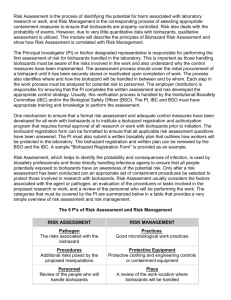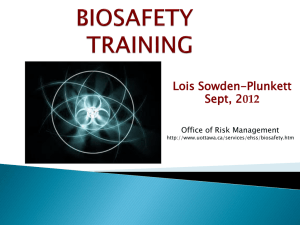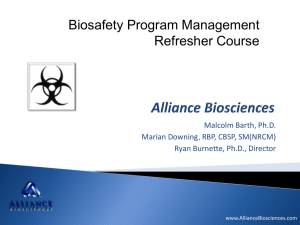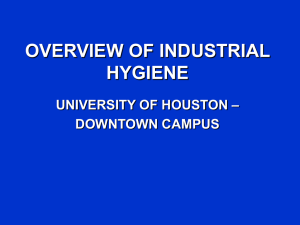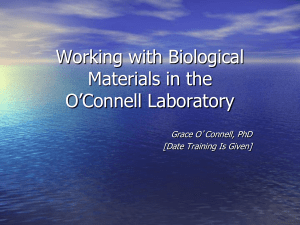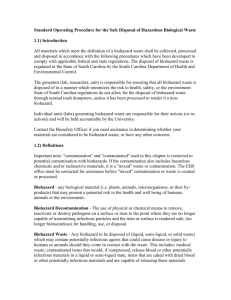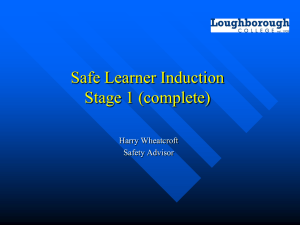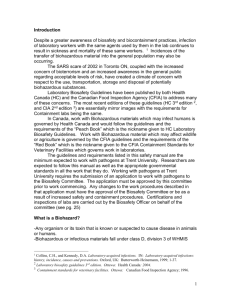Biosafety At the University of Ottawa
advertisement
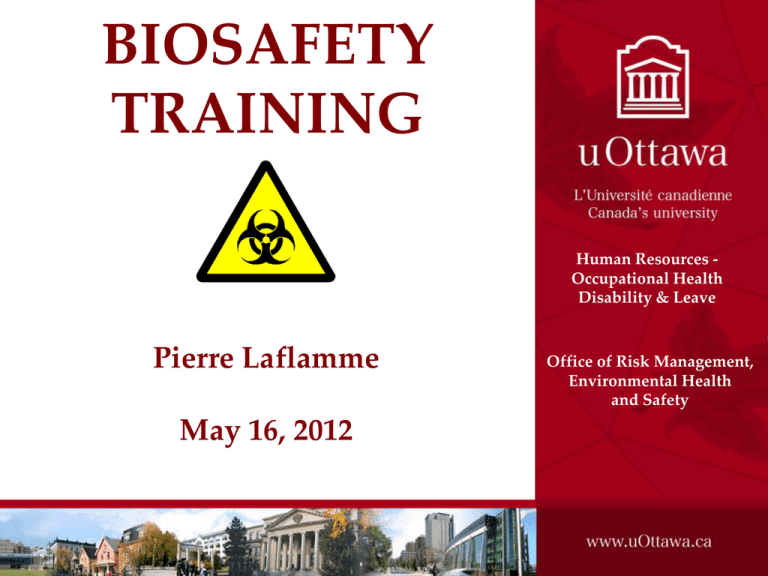
BIOSAFETY TRAINING Uottawa2k9 Human Resources Occupational Health Disability & Leave Pierre Laflamme May 16, 2012 Office of Risk Management, Environmental Health and Safety COURSE OUTLINE Introduction Laboratory Associated Infections Blood-borne Pathogens Classification of Biohazards Infection/Biohazard Control Spill Response BIOSAFETY Biomedical Waste Regulations INTRODUCTION What is a BIOHAZARD? Any organism or its toxin that is known to cause disease in humans or animals or that is a potential hazard to humans, animals or the environment. Examples: Microorganisms such as viruses, bacteria, fungi, and parasites and their toxins. Blood, body fluids and tissues from humans and animals. Transformed cell lines What is BIOSAFETY? The combination of measures employed when handling biohazardous materials to: Protect personnel from exposure to infectious agents Prevent environmental contamination Provide an environment for high quality research while maintaining a safe work place Comply with applicable federal, provincial and municipal requirements How is BIOSAFETY achieved? Administrative controls Training, Inspections, Permits and Certificates Engineering Controls Biological Safety Cabinets, Ventilation Personal Protective Equipment Practices and Procedures Medical Surveillance Immunization when necessary What is BIOSECURITY? Measures employed to protect biohazardous materials, or critical relevant information, against theft or diversion by those who intend to pursue intentional misuse. How is BIOSECURITY achieved? Physical barriers Buildings, doors, locks, key card access Psychological barriers Security personnel, cameras Monitoring Activities Patrols, monitoring by support staff Personnel Clearance Access to authorized personnel only Who are the STAKEHOLDERS? INTERNALLY EXTERNALLY Vice-President (Research) Committees University Services (ORM, HR, PRS, PS) Deans, Chairs, Principal Investigators Employees, Students Manager of Biological Containment Suite Public Health Agency of Canada Canadian Food Inspection Agency Environment Canada Transport Canada Ontario Ministry of Labour Emergency Response Personnel Suppliers & Contractors Community University KEY SERVICES Office of Risk Management, Environmental Health and Safety Certificates and Permits Training Procedures (Waste disposal) Risk Identification (Inspections) Emergency plans Accident/Incident follow-up University KEY SERVICES HR (Occupational Health, Disability and Leave) Medical surveillance Immunizations Medical Follow-up Interface with Workplace Safety and Insurance Board WHY ARE WE CONCERNED? Potential for acquiring a laboratory-associated infection (LAI) Contamination of the environment Contamination of research LABORATORY ASSOCIATED INFECTIONS LABORATORY ASSOCIATED INFECTIONS Infection Source Microorganisms Cells and tissues Blood and body fluids Any items contaminated with the above Susceptible Host Route of Transmission Immune system Vaccination status Age Percutaneous inoculation (needles and bites) Inhalation of aerosols Contact of mucous membranes Ingestion LAIs Only 20% of LAIs are related to a causative or defined event 80% are caused by human errors 20% are caused by equipment failure Types of accidents causing LAIs Spills and sprays Needles Sharp objects and broken glass Bites or scratches from animals http://www.weizmann.ac.il/safety/bio2.html BLOOD-BORNE PATHOGENS Human Resources Occupational Health Disability & Leave BLOODBORNE PATHOGENS (BBP) Sources Blood Semen Vaginal Secretions Other Bodily Fluids: Cerebrospinal Amniotic Synovial Tissue Cultures Organ Cultures Infected Experimental Animals RISK OF EXPOSURE Pathogen involved Type of body fluid Route of exposure Duration of exposure Volume of blood involved in exposure Concentration of virus at time of exposure PPE worn SPECIFIC EXAMPLES OF BBPS Hepatitis B Hepatitis C HIV FACTS ABOUT SOME BBPs Pathogen Hepatitis B Hepatitis C HIV Pathogenicity 2 major forms: • asymptomatic • symptomatic • asymptomatic • symptomatic • non-specific symptoms • acute infection: non-specific “flu-like”, “mono-like” symptoms Mode of transmission • percutaneous/ permucosal exposure to body fluids, organs • indirect contact with contaminated lab items (e.g. needles, syringes) • Percutaneous exposure to contaminated blood (102 – 103 infectious particles/ mL) • intravascular inoculation (e.g. transfusion) of contaminated blood products • direct exposure of virus to mucosa (oral, rectal, vaginal) Incubation period • usually: 24 - 180 days • average: 60-90 days • 2 weeks - 6 months • most commonly 7 – 10 weeks • chronic infection may persist up to 20y before onset of cirrhosis • variable • generally 1 - 3 months between time of infection to development of detectable Ab’s • time from HIV infection to diagnosis of AIDS ranges from < 1y to 15y or more Survival outside host • Survives in dried blood for long periods (weeks) • stable on environmental services for at least 7 days at 25 °C • not known • similar to hep B (survives in dried blood for long periods…weeks) • viable in blood in syringes @ RT for 42d • Cell-free HIV dried on glass coverslips in 10% serum can survive forlonger than 7d, depending on initial titre Laboratoryacquired infections (LAIs) • MOST FREQUENTLY occurring LAI • lab workers incident rate: 7X > general population • health care workers handling blood at higher risk to infection • low (e.g. as of 2001, total of 57 cases of documented occupationally acquired HIV among US health care workers [Source: http://www.phac-aspc.gc.ca/lab-bio/res/psds-ftss/index-eng.php] ISSUES TO CONSIDER Symptoms Mode of transmission Incubation period Survival outside host Communicability Immunization Prophylaxis / Treatment IF AN EXPOSURE OCCURS Initiate first aid Notify your supervisor / designated person Report to hospital emergency department or University’s Health Services Report incident to OHDL Occupational Health, Disability and Leave Office, ext. 1472 http://www.rh.uottawa.ca/00_main/index_f.asp UNIVERSAL PRECAUTIONS Minimum standard of practice for preventing the transmission of BBP includes: Education Hand washing Wearing protective barriers Use safe work practices If samples cannot be guaranteed noninfective …… treat as infectious! BIOHAZARD CLASSIFICATION BIOHAZARD CLASSIFICATION Conventional Agents – Risk Groups 1 to 4 Recombinant DNA Tissue Culture Animal Work Anatomical Specimens Unconventional Agents Class D, division 3 of WHMIS (Poisonous and Infectious Material - Biohazardous Infectious Material) BIOHAZARD CLASSIFICATION Conventional agents are categorized into risk groups based on their particular characteristics such as: Pathogenicity (Infectivity of the agent - disease, severity, mortality) Infectious dose Mode of transmission (Airborne, Ingestion, Parenteral) Host Range (Animal or human pathogen Availability of effective preventive measures (PPE) Availability of effective treatment BIOHAZARD CLASSIFICATION Conventional agents are categorized based on the measures required for handling each organism safely in a laboratory setting, such as: Operational Requirements (Protocols, Biological safety cabinets, Lab safety practices) Engineering Requirements (Maintenance, certification, repairs) Physical Requirements (PPE) CONVENTIONAL AGENTS Risk Group Individual Risk Community Risk Containment Level Examples 1 Low Low Level 1 Escherichia Coli Level 2 Bacteria: Streptococcus and Salmonella Viruses: Adenovirus, Hepatitis A, B & C, Influenza Level 3 Bacteria: Bacillus anthracis and, Mycobacterium tuberculosis Virus: HIV Level 4 Viruses: Ebola virus and Lassa virus Unlikely to cause disease in healthy workers or animals 2 Moderate Limited Rarely cause serious human or animal disease 3 High Low May cause serious disease 4 High High Likely to cause very serious disease RECOMBINANT DNA Recombinant DNA technology or genetic engineering: in vitro incorporation of genetic material from one cell into another or from one organism to another In Canada the level of risk depends on the source of DNA being transferred the vector the host The Office of Risk Management will assist the investigator in this determination. TISSUE CULTURE Mammalian cell lines have to be considered infectious as they may contain infectious agents Untransformed mammalian cell lines - Risk Group 1 MCF-7 (Human breast carcinoma cell line) NIH 3T3 (Mouse fibroblast cell line) Transformed mammalian cell lines – Risk Group 2 HeLa (Human - contains papovavirus) All mammalian cell lines should be handled in a Level 2 Containment. ANIMAL WORK Animals can harbour infectious agents (naturally or introduced) which can be transmitted to humans Scratches, bites, aerosols (needles and litter changes), body fluids and excrements Level dependent on type of work being conducted. Special Animal Care training is required for all personnel working with animals. All work involving animal use must receive prior approval from the Animal Care Committee ANATOMICAL SPECIMENS All specimens should be considered infectious due to potential presence of infectious agents It’s important to consider the type of specimen blood, organs, tissues Spinal sample, brain tissue From infectious patient In general Level 2 but it depends on the nature of the work. UNCONVENTIONAL PATHOGENS Includes unconventional agents, slow viruses and prions causing progressive neurological diseases Creutzfeld-Jakob disease in humans, Mad Cow Disease, Scrapie in sheeps and goats Resistant to destruction by chemical and physical procedures that normally inactivate viruses Precautions: Handle tissues as Risk Group 2 or higher Handle formalin-fixed tissues and paraffin-embedded blocks as if still infectious Follow up-to-date disinfection protocols. WHERE ARE BIOHAZARDS FOUND? Biology Earth Sciences Bio-Engineering University Engineering Civil Chemical Human Kinetics Chemistry Medicine/ Nursing INFECTION/BIOHAZARD CONTROL INFECTION/BIOHAZARD CONTROL 1. Administrative Controls 2. Engineering Controls 3. Personal Protective Equipment 4. Practices and Procedures INFECTION/BIOHAZARD CONTROL 1. ADMINISTRATIVE CONTROLS ADMINISTRATIVE CONTROLS Administrative procedures to minimize the risk of exposure: Risk assessment Training/Education Resources Inspections Permits and Certificates Medical Surveillance Signage ADMINISTRATIVE CONTROLS Risk Assessment Will determine for each biohazard: Risk group Containment level Operational practices Safety measures Responsibility of users Know and understand the various characteristics of the agent(s) you are working with. (Material Safety Data Sheets and suppliers or manufacturers information sheets) ADMINISTRATIVE CONTROLS Medical Surveillance Training & Education WHMIS Lab specific policies and procedures Biosafety training, Laboratory safety training Resources ORM web site, Biosafety page Faculty web sites Biosafety Manual Training Videos National and International Biosafety Guidelines ADMINISTRATIVE CONTROLS Inspections Routine self-inspections Biosafety Inspection Checklist available online In addition, ORM and Health, Safety and Risk Officers will inspect labs to ensure compliance with regulations/ guidelines and provide feedback. ADMINISTRATIVE CONTROLS Signs & Labeling Biohazard warning signs must be posted on doors to rooms where biohazardous materials are used and/or stored. Biohazard labels should be placed on containers, equipment and storage units used with biological agents. INFECTION/BIOHAZARD CONTROL 2. ENGINEERING CONTROLS ENGINEERING CONTROLS Technology based Reduce or eliminate exposure to hazards Containment: Types: Primary and Secondary Levels: 1, 2, 3 and 4 For effective containment, users must be aware of the potential hazards be trained Handle the material safely by adhering to standard microbiological practices and techniques PRIMARY CONTAINMENT First line of defence. Ensures protection of personnel and immediate environment from exposure to the infectious agent. ‘Protective envelope’ that encapsulates the infectious agent or animal. Petri dish, vial Biological safety cabinets animal caging equipment SECONDARY CONTAINMENT Protects the environment external to the laboratory from exposure Includes facility design and operational practices CONTAINMENT LEVEL 1 Basic laboratory Requires no special design features Biosafety cabinets are not required and work may be performed on the open bench. CONTAINMENT LEVEL 2 Clinical, diagnostic, research and teaching facilities with level 2 agents. Requires a class I or class II biological safety cabinet if any potential for aerosol or splash exists. An emergency plan for handling spills must be developed. Access should be controlled. CONTAINMENT LEVEL 3 Specialized design and construction with primary barriers to protect the individual secondary barriers to protect the environment Requires type II or type III biosafety cabinets All staff must undergo specific training on the agents used, PPE, equipment, waste management as well as practices and procedures. CONTAINMENT LEVEL 4 Only one level 4 facility in Canada (Canadian Centre for Human and Animal Health in Winnipeg, Man.) Design specifications are extremely stringent The worker is completely isolated from infectious material. BIOLOGICAL SAFETY CABINETS Primary containment Minimize contact between operator and the infectious agent by the use of directional airflows There are 3 main classes of cabinets (I, II, III) which provide various levels of protection. Class II and III BSC contain HEPA filters which remove particles (min 0.3 microns) from supply and exhaust air with 99.97% efficiency . BSC should be located away from doors and high traffic areas BIOLOGICAL SAFETY CABINETS Biological Safety Cabinet Laminar air flow and HEPA filtered exhaust air Personnel and environment protection HEPA filtered supply air & product protection with Class II + III To be used with biohazards Laminar Flow Hoods or Clean Air Benches Vertical or horizontal laminar flow HEPA filtered supply air only Provide product protection only Not to be used with biohazards VS WORKING SAFELY IN A BSC Step 1 Before using the cabinet: Turn off UV lamp; turn on fluorescent lamp Ensure BSC is certified Disinfect work surfaces with appropriate disinfectant Place essential items inside cabinet Allow the blower to run for 5-10 min before work WORKING SAFELY IN A BSC Step 2 While using the cabinet: Ensure material and equipment is placed near the back of the hood, especially aerosol-generating equipment. Do not block any vents Use techniques that reduce splatter and aerosols. General work flow should be from clean to contaminated areas Minimize movement so as not to impede air flow WORKING SAFELY IN A BSC Step 3 After using the cabinet: Leave blower on at least 5 minutes to purge cabinet Remove and decontaminate equipment and materials Disinfect cabinet surfaces Turn off blower and fluorescent lamp, turn on UV lamp WORKING SAFELY IN A BSC Maintenance: Before and after each use - Wipe down work surfaces Weekly - Clean UV lamp Monthly - Wipe down all vertical surfaces Annually - VerifyUV lamp intensity - Decontamination with formaldehyde gas (by ORM) - Certification (by ORM) INFECTION/BIOHAZARD CONTROL 3. PERSONAL PROTECTIVE EQUIPMENT PERSONAL PROTECTIVE EQUIPMENT PPE is an important line of defence Responsibility of both the user and the supervisor to ensure that PPE is worn PPE is specific to each containment level Examples of PPE? PPE Criteria for consideration Routes of exposure that need to be blocked Degree of protection offered Ease of use Only effective if correctly selected, fitted, used and cared for the individual is well trained Ensure PPE is removed before leaving the lab PPE Footwear Closed toe and heel shoes only. No sandals! Shoe coverings are worn in some higher containment labs and animal facilities. PPE Lab Coats/Gowns Protect street clothing from spills Offer additional body protection Long-sleeved, knee length with snaps Elastic cuffs Back-closing gowns Periodic cleaning required PPE Gloves Offer protection against a variety of hazards (heat, cold, chemical agents, biological agents, radioisotopes…) Latex, nitrile, rubber & vinyl for work with biological agents. Gloves should not be reused and should be changed frequently. Utility gloves can be disinfected and reused if they show no sign of degradation. PPE Eye & Face Protection Goggles, safety glasses to protect the eyes Full face shield to protect facial skin Offer protection against chemical and biological splashes No contact lenses Respirators Only personnel who have been fit-tested and trained should wear respirators. Worn in atmospheres that pose an infectious or toxic hazard MOVIE BREAK INFECTION/BIOHAZARD CONTROL 4. PRACTICES AND PROCEDURES PRACTICES AND PROCEDURES General Safety Guidelines Good Microbiological Practice Handwashing Receipt of Packages Opening Packages Specific Procedures Centrifuges Needles & Syringes and other sharps Pipettes Blenders, Grinders, Sonicators & Lyophilizers Inoculation Loops Cryostats GENERAL LABORATORY SAFETY GUIDELINES Understand the hazards you face in the laboratory Be adequately trained Appropriate PPE must be worn The lab should be kept clean and in order Long hair must be tied back Work surfaces must be cleaned and decontaminated daily The use of needles should be limited Lab doors have to be closed Access to the lab has to be restricted b i o s a f e t y 1. GOOD MICROBIOLOGICAL PRACTICE (GMP) Mitigates the risk of: 1. Personnel exposure 2. Contamination a) sample b) environment What are we talking about ? 2. GOOD MICROBIOLOGICAL PRACTICE (GMP) Universal Precautions: • More knowledge about the organism being used = easier to take the necessary precautions • Appropriate PPE greatly minimizes risk of exposure • Engineered controls (BSC’s) prevent release of aerosols outside cabinet (and helps protect user!) • Frequent hand washing = avoid infections 3. GOOD MICROBIOLOGICAL PRACTICE (GMP) • Prepare yourself for the work: o Know what you will be doing o Structure the work in a logical fashion (work flow) • Prepare the work area • Ensure all material that needs to be in the BSC is sterile before placing it there • Ensure waste containers are at hand’s reach and are not overflowing and likely to collapse/ fall over • Use aseptic technique • Consult web [http://www.protocol-online.org] for SOPs & techniques • Properly trained to use equipment accordingly and when in doubt…ASK! • Clean up and decontaminate 4. GOOD MICROBIOLOGICAL PRACTICE (GMP) • Disinfect work surfaces with suitable disinfectant before and after • Clean spills immediately and disinfect area thoroughly • Keep bench top uncluttered • Minimize traffic and unnecessary movements around work area • all work with infectious material should be carried out in a specific area • Material should not be carried throughout, or out of lab, unless in a closed or capped container • Minimize aerosol generation; if unavoidable, carry out activities in a BSC 5. GOOD MICROBIOLOGICAL PRACTICE (GMP) • Keep sterile and non-sterile objects separate • Minimize exposure to outside air • Avoid contact with non-sterile surfaces and items • Hold open containers at an angle whenever possible • Identify and properly dispose of different types of waste HANDWASHING One of the single effective means of preventing infections if done properly and frequently When to wash hands? Before starting any manipulations Before leaving the lab When hands are obviously soiled Before and after completing any task in a BSC Every time gloves are removed Before contact with one’s face or mouth At the end of the day RECEIPT OF PACKAGES At Shipping & Receiving Verify shipment is yours, and expected. Inspect the integrity of container. If damage and breakage possible, transfer the package into a secondary container lined with absorbent paper (absorbent side up) Transfer to a cart with 4 sides for transfer to lab. Decontaminate all the areas in S&R where the package came into contact with. All individuals who may have come into contact with the material must wash their hands REMEMBER AT THIS POINT YOU DO NOT KNOW IF THE SAMPLE HAS BEEN BE BREACHED ! OPENING PACKAGES – IN LAB Scenario 1: Package appears damaged. • Transfer the sample to a biological cabinet and open and inspect each layer of packaging confronted with for signs which would indicate the sample integrity. • If damaged, inform your supervisor and ORM (x. 3153) • Dispose of sample in the appropriate manner • Package must be sterilized or sent for incineration. OPENING PACKAGES – IN LAB Scenario 2: Package is intact. • Open package in the containment level required by the sample • Add sample to inventory • Read and file MSDS or supplier information sheet • Deface all markings on the package prior to disposal SAFE USE OF CENTRIFUGES Before use Check centrifuge tubes for cracks Avoid Overfilling Place caps or stoppers properly Balance loads Use sealed buckets (safety cups) or sealed rotors Before leaving: ensure centrifuge achieves run conditions After run Centrifuge has to be completely stopped before opening the lid Check for spills or leaks before removing samples. Clean spills Allow aerosols to settle (30 min) or open in a BSC NEEDLES AND SYRINGES Avoid use whenever possible Use a BSC for all operations with infectious material Fill syringes carefully Shield needles when withdrawing from stoppers Do not bend, shear or recap needles. Dispose of all used needles/syringes in yellow sharps containers PIPETTES Mouth pipetting is prohibited. Never force fluids out. To avoid splashes, discharge the liquid down the receiving container wall. Never mix material by suction and expulsion. Reusable pipettes should be placed horizontally in a disinfectant filled pan. BLENDERS, GRINDERS, SONICATORS, AND LYOPHILIZERS • Operate in a BSC whenever possible. Allow aerosols to settle for 5 minutes before opening. • Decontaminate after use • Blender Do not use glass blender jars Use safety blenders which can be autoclave • Lyophilizers (used for dehydration process) Use glassware designed for vacuum work, ensure there is no damage before using Use vapour traps whenever possible INOCULATION LOOPS Sterilization in an open flame may create aerosols which may contain viable microorganisms. Shorter handles minimize vibrations Disposable plastic loops are good alternatives CRYOSTATS Wear gloves during preparation of frozen sections and heavy gloves when accessing the cryostat. Decontaminate frequently (70% Ethanol) SPILL RESPONSE SPILLS Spill response will vary depending on: What was spilled? How much was spilled? Where was the spill? What is the potential for release to the environment? Spills should be cleaned up immediately (unless an aerosol was generated), to ensure proper decontamination. Ensure appropriate PPE is worn and clean-up equipment is readily available. SPILLS-GENERAL CLEAN-UP Cover spill area with absorbent material Soak the spill area with an appropriate disinfectant (i.e. 10% bleach) Pour disinfectant from the outside of the absorbent material towards the inside Leave on for 20 to 30 minutes Pick up any broken glass (with forceps!) and place in a sharps container Wipe up with absorbent material Waste should be disposed in appropriate biohazardous waste container SPILLS-SPECIAL CASES Within a Centrifuge Within a BSC Open Areas (lab, during transport) The spill response plan template is available at (http://www.uottawa.ca/services/ehss/d ocs/SPILLRESPONSEPLAN.pdf) SPILLS All users of biological materials should be familiar with the spill clean-up procedures. All spills are to be reported ASAP to the lab supervisor and ORM. Additional assistance is available from: ORM x 5892 Your departmental safety officer ERT x 5411 (through Protection Services) BIOMEDICAL WASTE DECONTAMINATION, DISINFECTION, AND STERILIZATION Decontamination: The destruction of microorganisms to a lower level such that it removes danger of infection to individuals. Sterilization: The complete destruction of all viable microorganisms. Disinfection: Use of agents (physical or chemical) to destroy harmful organisms on inanimate objects DECONTAMINATION: PHYSICAL Heat: Autoclaving (most practical and recommended) Incineration (for disposal of sharps and tissues) Irradiation: UV light (wavelength of 253 nm is germicidal) Gamma (disrupts DNA and RNA) Filtration HEPA (biological safety cabinets, ventilation) AUTOCLAVES Items that CAN be autoclaved: Cultures and stocks of infectious material Culture dishes and related devices Discarded live and attenuated vaccines Contaminated solid items (petri dishes, eppendorf tips, pipettes, gloves, paper towels) AUTOCLAVES Items that CANNOT be autoclaved: chemicals (flammables, oxidizers, phenols, acids, alkalides) chemotherapeutic or radioactive waste bleach (or other chlorinated products) certain kinds of plastics Sharps (not at the University of Ottawa) AUTOCLAVES Preparation of waste: Use only approved autoclave bags Do not overfill autoclave bags Separate material for re-use from that which will be disposed, and dry from liquid material If outside of bag is contaminated, double bag All flasks containing biological material should be capped with aluminum foil Ensure items are labeled with contact information SAFE USE OF AUTOCLAVES Many autoclaves are now run by dedicated staff, however, if you are operating an autoclave: Learn how to use it! Ensure PPE is worn Recognize acceptable material and packaging Proper loading and unloading All users/operators must take the autoclave training DISINFECTION: CHEMICAL Generally for disinfection rather than sterilization Choice depends on: Type of material to be disinfected Organic load Chemical characteristics Most common are chlorine compounds and alcohols (broad range) WHAT TO USE FOR MY AGENT? Vegetative bacteria (E.coli, Staph) Viruses Enveloped (HIV, Herpes) 2% domestic bleach 75% Ethanol Quaternary ammonia 6% formulated Hydrogen peroxide Mycobacteria and fungi 10% domestic bleach 75% Ethanol Phenolic compounds 6% formulated Hydrogen peroxide Spore forming bacteria (Bacillus) 10% domestic bleach Gluteraldehyde Formaldehyde 6% formulated Hydrogen peroxide 2% domestic bleach 75% Ethanol Quaternary ammonia 6% formulated Hydrogen peroxide* Non enveloped (Hepatitis, Adenovirus) 10% domestic bleach 6% formulated Hydrogen peroxide* Gluteraldehyde Formaldehyde WASTE MANAGEMENT Discarded biological material from teaching, clinical and research laboratories and operations is biomedical waste. Biomedical waste includes but is not limited to: Animal waste Biological laboratory waste Human anatomical waste Human blood and body fluid waste Sharps WASTE MANAGEMENT All biological waste should be decontaminated prior to disposal (including level 1 agents). Treated waste is no longer considered ‘biomedical’ (i.e. microbiological waste, blood and bodily fluid waste) and can be disposed of in the regular waste stream. Any waste that cannot be treated (i.e. sharps, carcasses, tissues and body parts) remains biomedical waste and must be incinerated off site. LABEL YOUR WASTE IDENTIFY CONTENTS WASTE DISPOSAL Biomedical Waste (untreated) WASTE DISPOSAL Biomedical Waste (treated) *in compliance with sewer use by-laws with H2O (1:10) REGULATIONS KEY REGULATED ACTIVITIES Purchasing & Receiving of Biological Agents PHAC, CFIA, Environment Canada Inventory Records Transportation/Transfer Transport Canada- TDG All Agencies (provincial and federal) emphasize and expect Biosecurity PURCHASING Importation permits required by Public Health Agency Canada (PHAC) or Canadaian Food Inspection Agency (CFIA) for certain agents Material Transfer Agreements (MTAs) between importer & exporter US restrictions Ensure you meet all criteria and have all pertinent documentation BIOMATERIAL ACQUISITION/ MTAs “How soon do you need it?” “You want it when?” In order to facilitate a quick turnaround, provide ORM with: copies of MSDS’s references (hardcopies) as much background information re: product as possible INVENTORY What material is presently being used and/or stored Location Expiry date Use log book for remaining amount MSDS’s Mandatory SHIPPING AND RECEIVING Transportation of Dangerous Goods Act: Class 6.2 (Infectious Substances) PHAC/CFIA restrictions Ensure: Proper classification Proper packaging Proper labeling Proper documentation Import/Export Permits TRANSPORTATION OF DANGEROUS GOODS Pre-approved Authorized Individuals Lead time (International Regulations….) Appropriate Scheduling (Holidays, Weekends) Transportation within the building Between lab to lab Colleague to Colleague Between Institutions TRANSPORTATION Important Considerations: does material need to be transported at all packaging requirements means and route of transportation regulatory requirements Between lab transfers - 4 sided cart, sealed primary container, secondary container, low traffic route. Off Campus transfers – consult ORM THE BOTTOM LINE If you are not careful and diligent with biological agents you risk: Infecting yourself, others or the environment Contaminating your research Having Public Health Agency of Canada, Canadian Food Inspection Agency, Ministry of the Environment or Transport Canada after you BIOSAFETY WEBSITE http://www.uottawa.ca/services/ehss.biosafety.htm Biohazardous Materials User Registration Biosafety Health Assessment Survey Practical Training Form MOVIE
